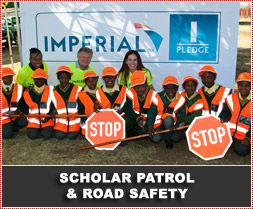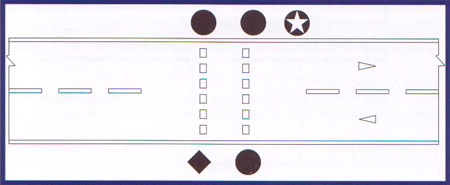
TYPE G: OPEN CROSSING (non surfaced roads, provincial and rural roads where engineering infrastructure is absent and surfaced roads where speeds are in excess of 80 kph).
COMPOSITION: 1 captain, 1 leader and 3 members
EQUIPMENT:
| TYPE |
QUANTITY |
LIFESPAN |
| Per team: |
| Caps |
5 |
1 year |
| Lapel Badges: |
|
|
| Captain |
1 |
1 year |
| Leader |
1 |
1 year |
| Member |
3 |
1 year |
| Whistle |
1 |
1 year |
| Per Crossing |
| Jackets: |
|
|
| Captain |
1 |
3 years |
| Leader |
1 |
3 years |
| Member |
3 |
3 years |
| Pre-warning signs |
2 |
3 years |
POSITIONING OF THE TEAM
The team members position themselves as follows at this type of crossing : the captain and two members at the side from which the crossing is done, and the other member, together with the leader, at the opposite side of the street.
PROCEDURE
Pedestrians are prevented from crossing by the team members on the one side of the street and the leader and member on the opposite side of the street. Once the leader has made sure that there is a big enough gap in the flow of traffic, the members respond as follows to the whistle of the leader :
- Whistle 1: Once the leader has ensured that the traffic situation is safe, the order for pedestrians to cross can be given. Members drop their arms and pedestrians cross.
- Whistle 2: Members opposite leader lift their arms to stop pedestrian flow. When crossing is clear, leader and member block crossing (now empty).
- Pupils must be taught to cross the road between the scholar patrol members only.
- Special training must be given to scholar patrol members especially the leader with regard to depth perception.
